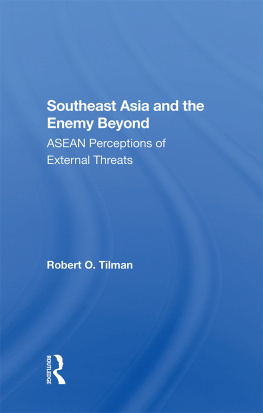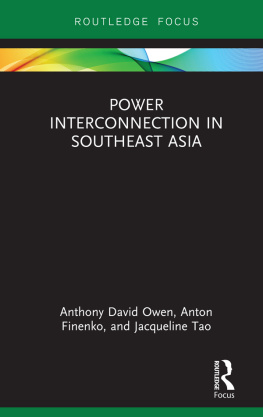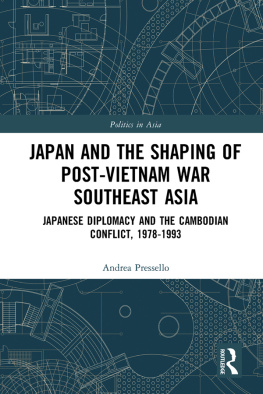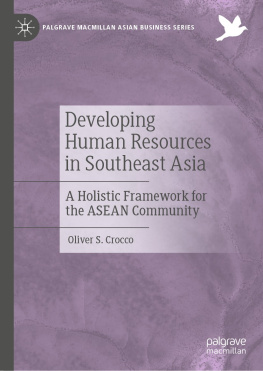Southeast Asia and the Enemy Beyond
Institute of Southeast Asian Studies
The Institute of Southeast Asian Studies was established as an autonomous organization in May 1968. It is a regional research center for scholars and other specialists concerned with modern Southeast Asia, particularly the multi-faceted problems of stability and security, economic development, and political and social change.
The Institute is governed by a twenty-two-member Board of Trustees comprising nominees from the Singapore Government, the National University of Singapore, the various chambers of commerce, and professional and civic organizations. A ten-member executive committee oversees day-to-day operations; it is chaired by the director, the Institute's chief academic and administrative officer.
About the Book and Author
This book explores elite perceptions of the external threats facing the members of the Association of Southeast Asian Nations (ASEAN), drawing on Dr. Tilman's interviews with senior political, military, and intellectual leaders in Indonesia, Malaysia, the Philippines, Singapore, and Thailand. He supplements his interviews with an examination of their writings, speeches, and other public statements, which he examines in the context of the history, geography, culture, and governmental structures of each country. He addresses the fundamental questions of the extent to which these perceptions differ and why. His focus throughout is on subjective reality--the world as it is perceived by the leadership of the ASEAN nations.
Robert O. Tilman is professor of political science at North Carolina State University and has published widely on Southeast Asia.
Published under the auspices of the Institute of Southeast Asian Studies, Singapore
Southeast Asia and the Enemy Beyond
ASEAN Perceptions of External Threats
Robert O. Tilman
First published 1987 by Westview Press, Inc.
Published 2019 by Routledge
52 Vanderbilt Avenue, New York, NY 10017
2 Park Square, Milton Park, Abingdon, Oxon OX14 4RN
Routledge is an imprint of the Taylor & Francis Group, an informa business
Copyright 1987 Taylor & Francis
All rights reserved. No part of this book may be reprinted or reproduced or utilised in any form or by any electronic, mechanical, or other means, now known or hereafter invented, including photocopying and recording, or in any information storage or retrieval system, without permission in writing from the publishers.
Notice:
Product or corporate names may be trademarks or registered trademarks, and are used only for identification and explanation without intent to infringe.
Library of Congress Cataloging-in-Publication Data
Tilman, Robert O.
Southeast Asia and the enemy beyond.
(Westview special studies on South and Southeast
Asia)
Includes index.
Bibliography: p.
1. Asia, Southeastern--Foreign relations. 2. ASEAN.
I. Title. II. Series.
DS526.7.T56 1987 327.59 86-1720
ISBN 13: 978-0-367-28803-7 (hbk)
TABLES
I have long been fascinated by the distinction between "reality" and "perception," but it was only during a whirlwind lecture tour of Southeast Asia in 1980 that I came to realize the extent to which perceptions may vary from one nation to another, and, within a single country, from one group to another. I returned to my university determined to pursue this question further. Because of my administrative responsibilities at that time I did not progress as rapidly as I would have liked. However, the delay proved to be a useful gestation period for my thoughts and a good excuse for several subsequent trips to the field. Indeed, as the project matured over a five-year period I came to appreciate the underlying similarities of perceptions as much as the differences, and this theme will surface frequently throughout the study.
Although I have been supported by numerous foundations during my more than a quarter-century of research in Southeast Asia, this book is the result of the support of five institutions and programs that have provided the funds to maintain me in Southeast Asia on four occasions since 1980. The lecture tour in 1980 that gave birth to this study was supported by the United States Information Agency (USIA, but at that time the United States International Communications Agency), and, despite a gruelling schedule of forty presentations in ten cities in five weeks, it was a rewarding and instructive experience. The lecture tour was followed by a Fulbright research award to the Institute of Southeast Asian Studies (ISEAS) in Singapore in 1983, fellowships from the Social Science Research Council and the Earhart Foundation for a four-month visit to ISEAS and the region in 1985, and an award from my university to permit me to return to Manila following the People Power Revolution in February 1986. With the exception of the last trip, each visit included a complete tour of ASEAN (except Brunei, which only joined the Association in 1984).
As I have noted elsewhere in this study, the cooperation I have received from the leadership of the ASEAN states goes well beyond what might be reasonably expected from busy leaders. In fact, they gave unsparingly of their valuable time--rarely on just one occasion and frequently many times. Very few of the top leaders proved not to be available at all, and in several cases in which they were not available they put documents and assistants at my disposal that proved to be of great value. If I left the region uninformed or misinformed it is my fault and not theirs.
The reader should be forewarned that I have great respect for most of the leaders with whom this study is concerned and great admiration for their accomplishments. Some are personal friends and will remain personal friends in or out of office. Thus, although I have tried to pursue this study with scholarly objectivity, and I hope I have succeeded, I did not approach it with hostility or even indifference. I was once introduced to a seminar in Bangkok as "an honorary Southeast Asian," and I regard this as one of the highest compliments I have been paid in any introduction. This comment is probably sufficient to give the reader a sense of my own perspectives.
During many visits to the region, ISEAS in Singapore has provided me with comfortable facilities, valuable research materials, a helpful staff, and stimulating colleagues. I owe a great debt to the Institute and its Director. The assistance and hospitality of the Institute of Security and International Studies in Bangkok and the Centre for Strategic and International Studies in Jakarta have also been valuable and appreciated on many occasions.
Finally, my wife has served as a research assistant (unpaid, of course) on most of our travels, and much of the material copied, clipped, or noted was provided by her. She has my gratitude for her scholarly contributions, but, probably more important, for the mobility and flexibility she has had to demonstrate during the past twenty-five years.
Despite my many debts to institutions and individuals, they cannot be blamed for errors of omission or commission. These are mine alone.
Robert O. Tilman
1
The Tiger at the Door: Threats and Threat Perceptions
O, wad some pow'r the giftie gie us To see oursels as ithers see us!








